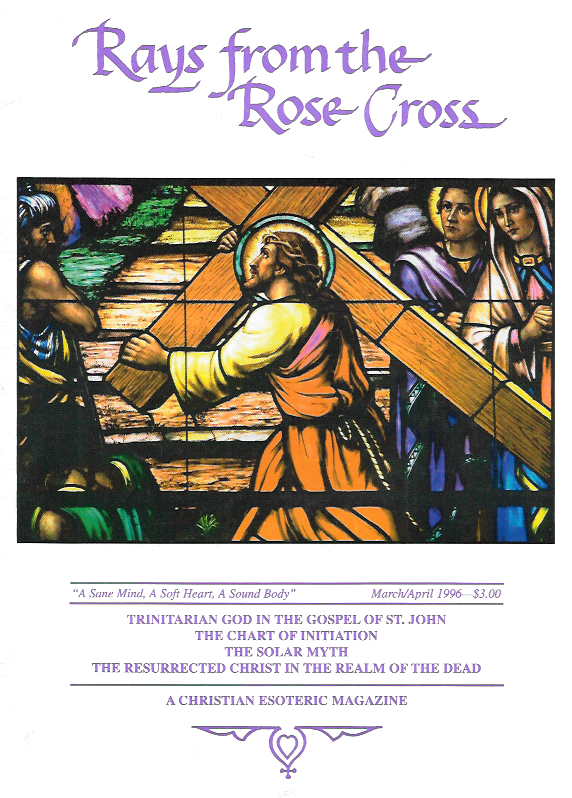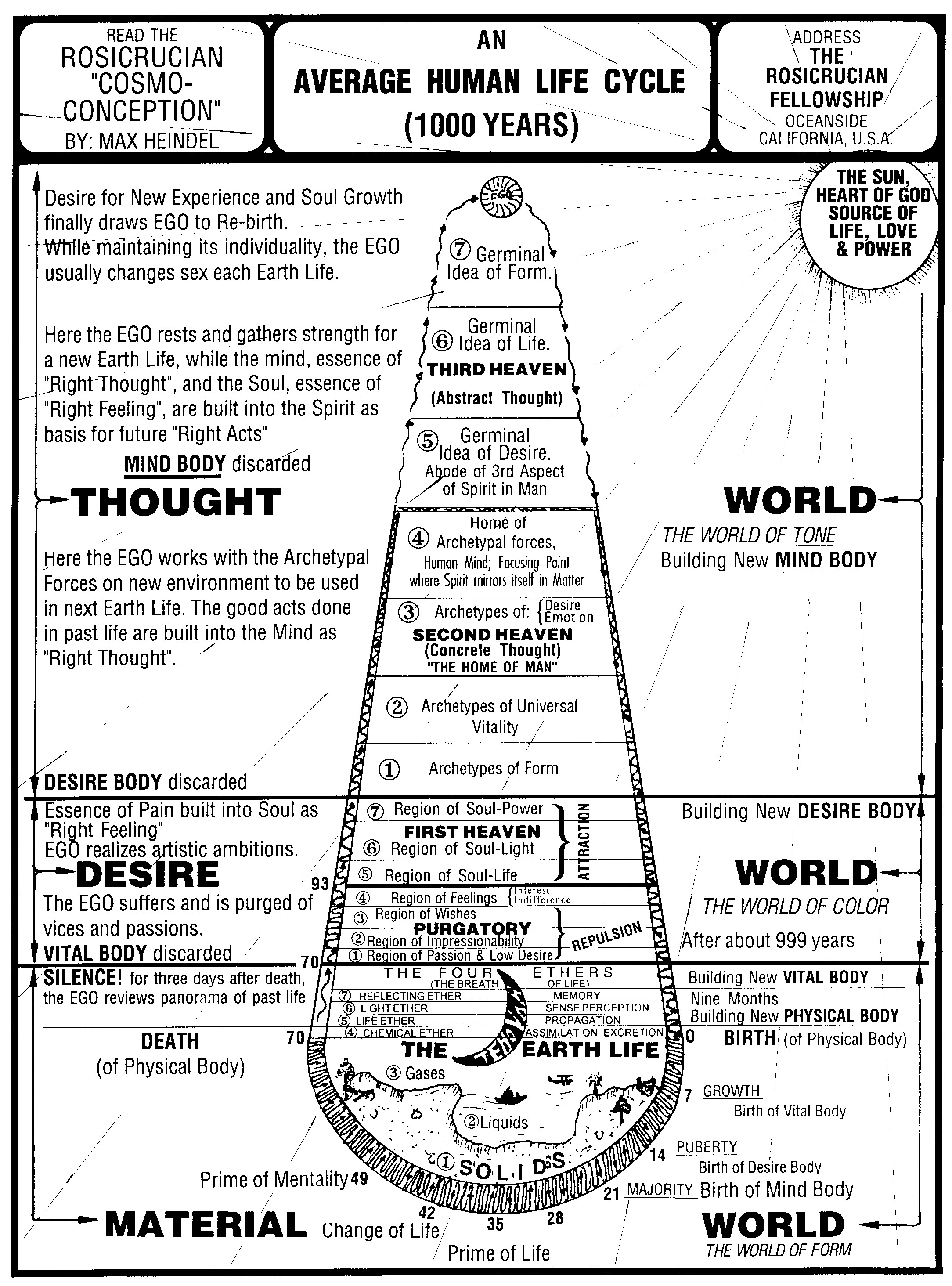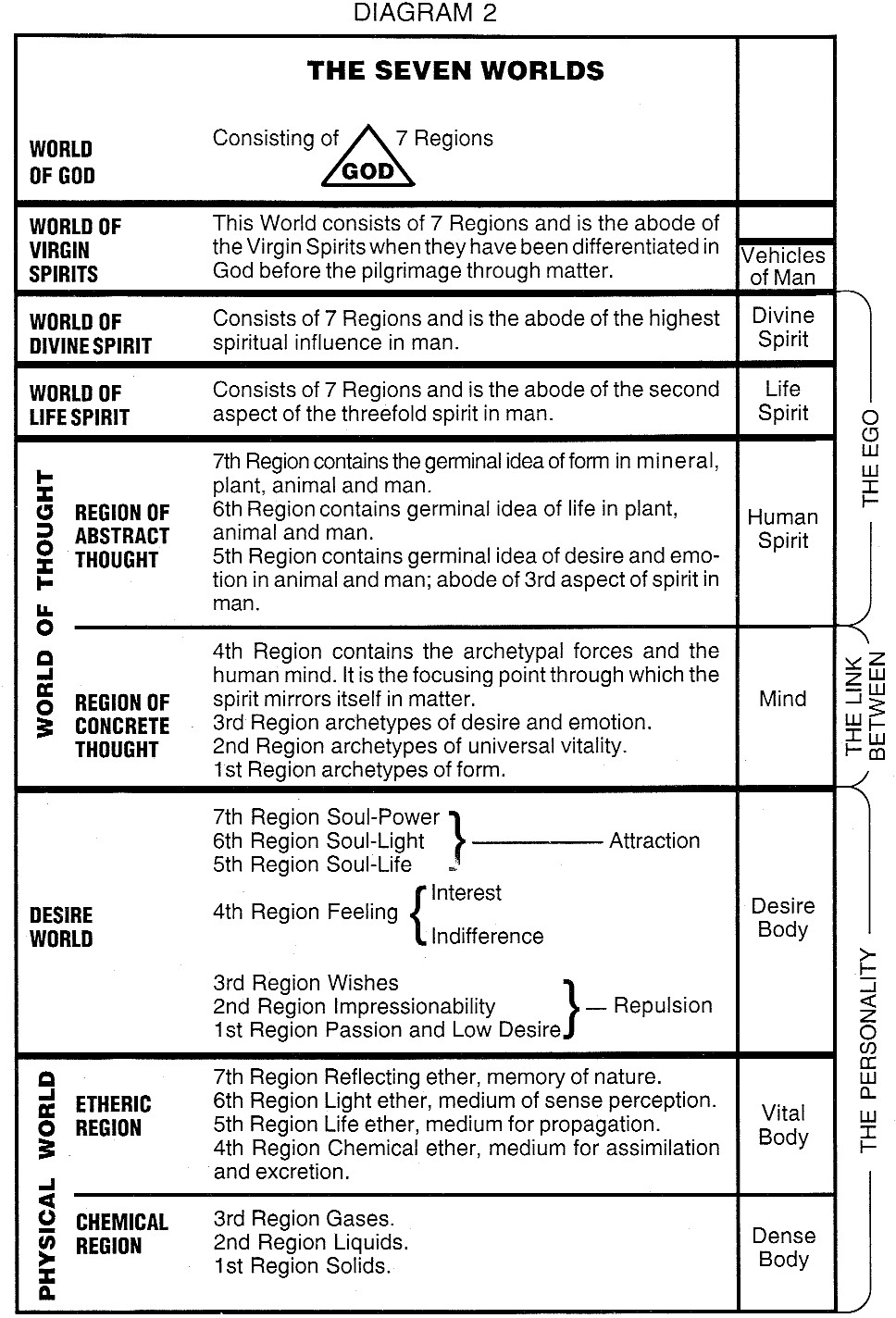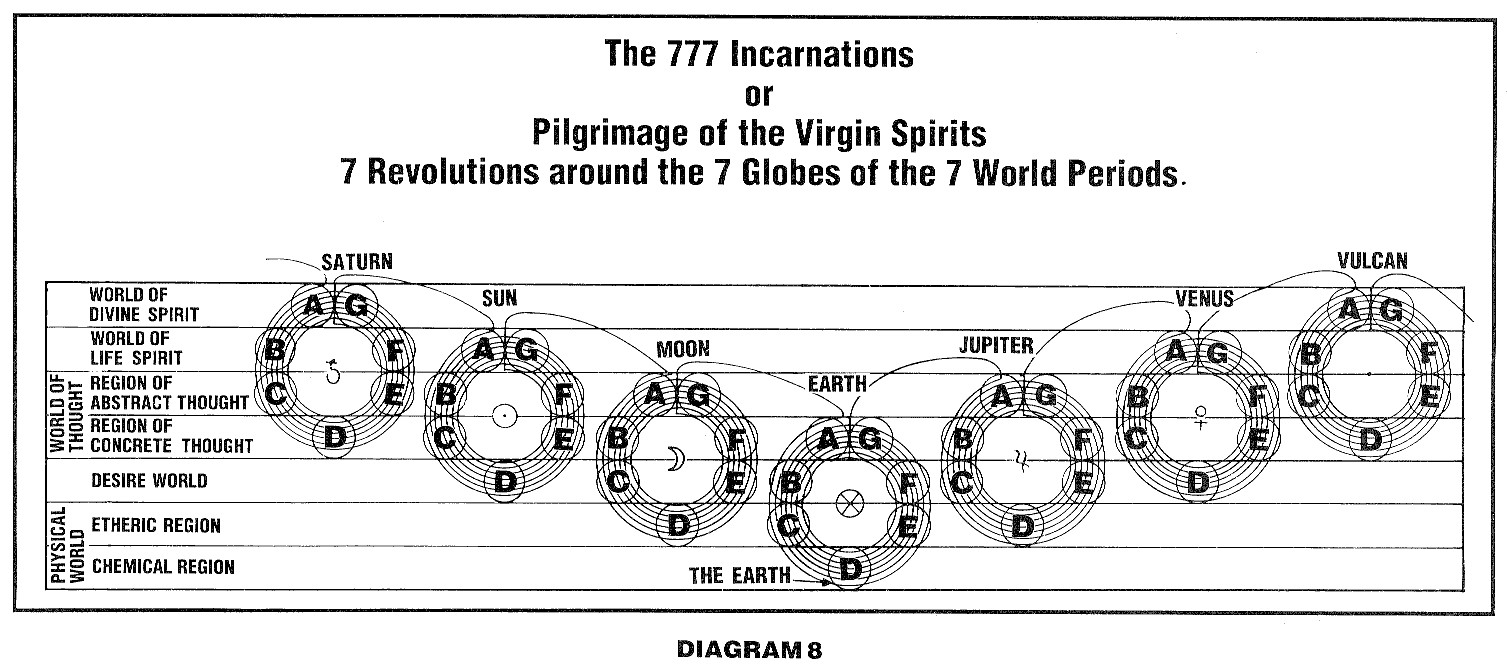
| rosicrucianU.com | ||
| Simplified Scientific Christianity |

Great Mandala: Mars in Aries; Venus in Taurus; Mercury in Gemini; Moon in Cancer; Sun in Leo; Mercury in Virgo; Venus in Libra; Mars in Scorpio; Jupiter in Sagittarius; Saturn in Aquarius; Jupiter in Pisces.
Before proceeding with further analysis of individual patients, let us examine some of the concepts of medical astrology so that we may become better attuned to the spiritual purpose of these studies.
The natal horoscope is a symbolic picture of a human being's rebirth into the material world. The Ego brings into rebirth personality traits, interests, talents, limitations, and degrees of understanding and self-control which uniquely reflect the experience of past lives. Man's present evolution utilizes a four-fold body as the vehicle in which man's three-fold spirit acquires experience.
A natal horoscope has multiple levels of meaning. On one level we look for correlations between the birth chart and the person's physical characteristics. A planet in a particular sign correlates with strengths or weakness of the physical structures which the sign is said to rule. The sign on the Ascendant gives a clue to the physical appearance of the person.
The energy of the person and relative function of the bodily organs are not only dependent upon the anatomic structure but also reflect the vital forces which flow through the organs. We recognize that these are the functions of the vital body. Thus a second level of analysis of the natal chart involves an assessment of the person's vitality. The twelve signs represent a spectrum of life energy.
Compare the relative energies of fire and water signs. Compare the relative energies of cardinal, fixed, and mutable signs of the same element. Similarly the planets in the chart symbolize a spectrum of vital energy.
The next level of analysis of a natal chart involves the desire nature of the person. The planets are associated with various human emotions as indicated in these familiar examples: dignified Sun, cheerful Venus, melancholy Saturn, optimistic Jupiter, and discordant Mars. The sign placement and aspects of the planets give clues to the person's emotional development. What planetary aspects would you expect to find in the chart of an unhappy person who encloses himself in a shell of fear and gloom? What pattern might you find in the chart of an angry, impulsive person who alienates his or her associates? In these instances what kind of emotional growth would help each person overcome these problems?
An important part of astro-analysis is the assessment of the mental development of the person whose chart we study. The pattern of the Moon helps us understand the person's reflective mind. Thought shaped by customs, feelings, memories, and imitation are associated with the Moon. The pattern of Mercury indicates a person's mode and capacity for reasoning and communicating.
In evaluating a natal chart we need to ask ourselves what planets and aspects constitute the major focus in the person's life. What planets are highlighted by sign position, aspects, and rulership? What planets are minimally active? In the great mandala above, the planets Uranus, Neptune, and Pluto have been purposely omitted. This is to remind us that these cannot be considered prominent in the personal lives of men and women at the present time. The lessons taught by the lower octave planets Venus, Mercury, and Mars need to be mastered before the spiritual qualities of these outer planets can be properly expressed.
After examining the details of a chart we should try to create a comprehensive picture which integrates the component parts. We may ask ourselves how the pattern in the natal horoscope serves the needs of the three-fold Spirit born at that moment. What opportunities has the Ego been given to express its free will? Why is it improper to use the chart to make predictions about the person's future health and illnesses?
Medical astrology is a blending of science and religion. It gives us in sight into the spiritual purpose of rebirth and each man or woman's plan for evolution in the present life. Think of how remarkable it is that a given planetary aspect can simultaneously represent a physical structure, a biological function, an emotional pattern, and a spiritual lesson.
Great Mandala (Refer to Part One):
As a first step in studying the relationship between the signs of the zodiac and human anatomy, we will divide the body into twelve areas, each represented by a major anatomic structure: Aries-head; Taurus-throat; Gemini-lungs; Cancer-stomach; Leo-heart; Virgo-intestines; Libra-kidneys; Scorpio-genitals; Sagitttarius-hips; Capricorn-knees; Aquarius-ankles; Pisces-feet.
Each region of the body consists of complex tissues including nerves, muscles, membranes, skin, blood, and bone. Each region has a different function, yet each is constructed from the same building blocks. In Part One we studied various levels of meaning in the analysis of a natal horoscope. Similarly, the astro-analysis of human anatomy is understandable when we consider various levels of association between signs, planets, and the human body.
In what was do opposite signs serve similar functions? Pisces rules the feet; Virgo rules the hands. Aquarius rules the ankles; Leo rules the wrists. Capricorn rules the knees; Cancer rules the elbows. Sagittarius rules the hips; Gemini rules the shoulders. The creative force of the genital organs and the lower spine, ruled by Scorpio and Libra, is reflected in the development of the larynx and the brain ruled by the opposite signs Taurus and Aries.
How do the anatomic structures ruled by the four cardinal signs work together? The functioning of the brain (Aries) is essential for life in the material world. The brain's metabolism depends upon glucose derived from ingested food. Man's awareness of hunger is associated with the function of the stomach (Cancer). The kidneys (Libra) serve an important role in maintaining the proper concentration of water, salts, and other metabolic products in the body. Waste products are eliminated and essential nutrients are retained. The skin (Libra and Capricorn) contains sweat glands which, like the kidney, have the capacity to excrete fluid. The skin provides the body with a protective coating which holds in body fluids. By secreting sweat the skin plays an important role in regulating body temperatures.
When one sees how the brain, stomach, kidneys, and skin each contribute to the maintenance of bodily function, it should not be surprising that disease in one area may be manifested by symptoms in another, it should not be surprising that disease in one area may be manifested by symptoms in another. Abnormal eating habits (Cancer) which overload the body with waste products can result in eczema of the skin (Capricorn). Renal failure (Libra) can lead to the state of impaired brain function known as coma (Aries). A person with diabetes mellitus has high concentrations of sugar in the blood due to an insufficient production of insulin by the pancreas (Cancer) and habits of overeating (Cancer). In response to the high blood sugar the kidneys (Libra) excrete large amounts of sugar in the urine. The diabetic patient is subject to skin infections (Libra, Capricorn) and can develop impaired vision from deposits in the retinas of the eyes.
Organic functions associated with the fixed and mutable signs are as follows: Taurus-thyroid; Gemini-respiration; Leo-liver; Virgo-assimilation; Scorpio-colon; Sagittarius-arterial system; Aquarius-blood; Pisces-lymph.
Great Mandala (Refer to Part One):
"The Sun contains in itself all the inherent powers and qualities specialized in other planets, and the planets abstract from the Sun certain properties and transmit them to the Earth Sphere in modified form." (H. L. Cornell, "Encyclopedia of Medical Astrology.") This quotation should help us think about the relationship of the planets to life on Earth. In what ways does man resemble the Sun? Max Heindel in "Simplified Scientific" has given us concise definitions of the spiritual relationship between the planets and man:
Sun: Man's highest spiritual aspect, the Divine Spirit whose faculty is Will. Venus: Intuition and Imagination, Love, the cementing influence in the life whereby we are attracted to others for mutual benefit. Jupiter: Man's Human Spirit, whose faculty is abstract thought. Mars: Outgoing energy of the lower nature, the Desire Body, the passional and emotional aspect of man. Saturn: The seed-atoms of man's lower vehicles, wherein are stored the experience of all past lives. Moon: The symbol of the Vital Body. Together with the Ascendant, denotes the formation of the physical body. Mercury: The lower concrete mind, a vehicle for the expression of other planets.
The first correlation we make between the planets and human anatomy is the relationship between the planets and the organs associated with the signs which the planets rule:
Sun: heart (Leo) Moon: stomach (Cancer) Jupiter: Arterial system (Sagittarius), fibrin of blood (Pisces) Saturn: skin, connective tissue (Capricorn), circulation of the blood (Aquarius) Venus: throat (Taurus), kidneys (Libra) Mars: head (Aries), genitals, colon (Scorpio) Mercury: lungs (Gemini), small intestines (Virgo)
Each planet is associated with one of the major types from which the human body is constructed: Sun-blood; Moon-serous and mucous membranes; Jupiter- arteries; Saturn-bones; Venus-veins; Mars-muscles; Mercury-nerves.
How do you think an afflicted planet in a particular sign can affect the entire body?
Each planet rules specific molecules which contribute to the biochemical reactions of the body: Sun-oxygen, protein; Moon-water; Jupiter-fat, glycogen; Saturn-carbon, calcium; Venus-sugars; Mars-hemoglobin; Mercury-nerve fluid (ether).
The planets rule various processes which involve the alteration and metabolism of cells: Sun-Structural change (genetic); Saturn-stenosis, narrowing; Jupiter-hypertrophy, enlargement; Moon-secretion; Venus-retrogressive metamorphosis (degeneration); Mercury-irritation and periodicity.
The placement of a planet in a particular sign has influence over the planet- ruled tissue in the parts or organs ruled by the sign. For example, the placement of each planet in Leo affects the heart as shown: Sun-structure of the heart; Moon-function of the heart (vitality); Jupiter- right atrium, arteries; Saturn-left atrium, endocardium; Venus-veins of heart, aorta; Mars- heart muscle; Mercury-nerves of heart.

|

|

|
|
|
Contemporary Mystic Christianity |
|
|
This web page has been edited and/or excerpted from reference material, has been modified from its original version, and is in conformance with the web host's Members Terms & Conditions. This website is offered to the public by students of The Rosicrucian Teachings, and has no official affiliation with any organization. | Mobile Version | |
|